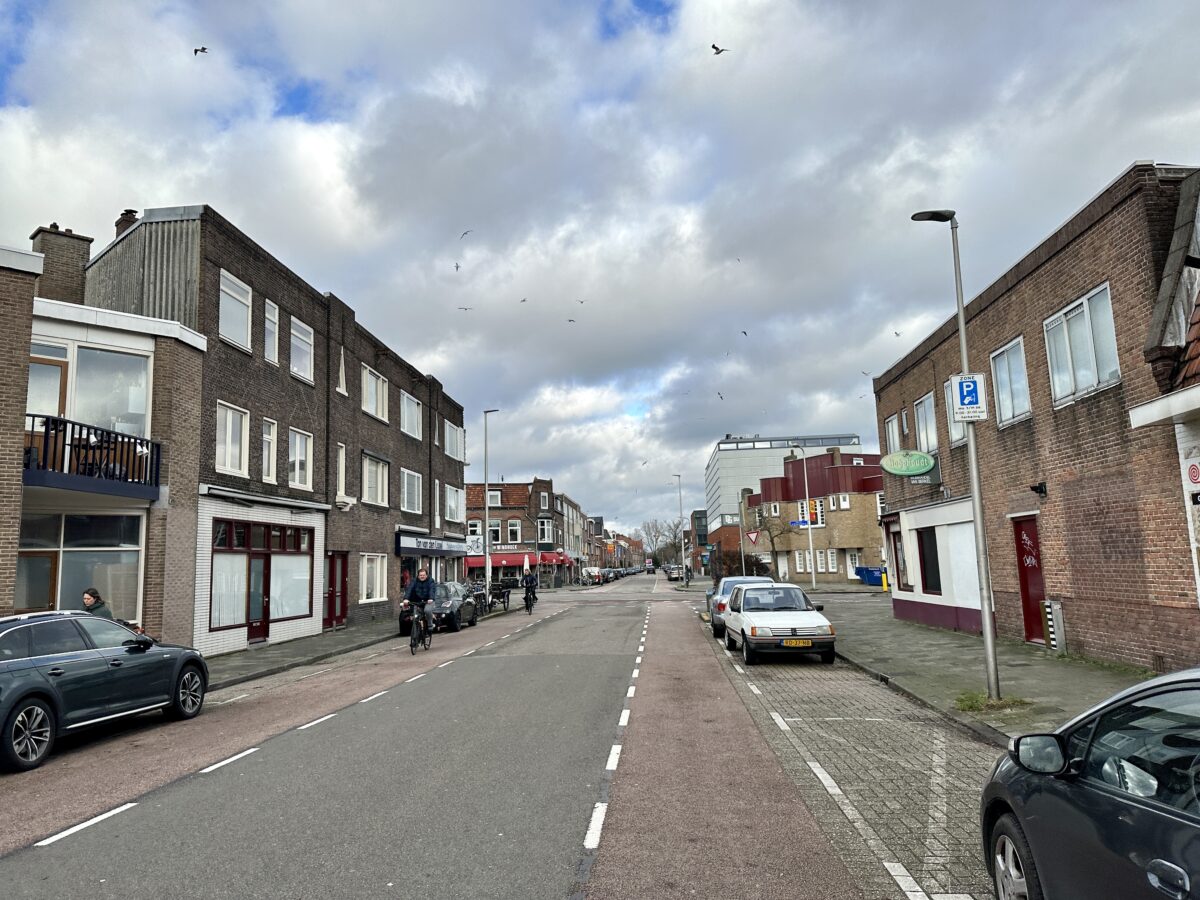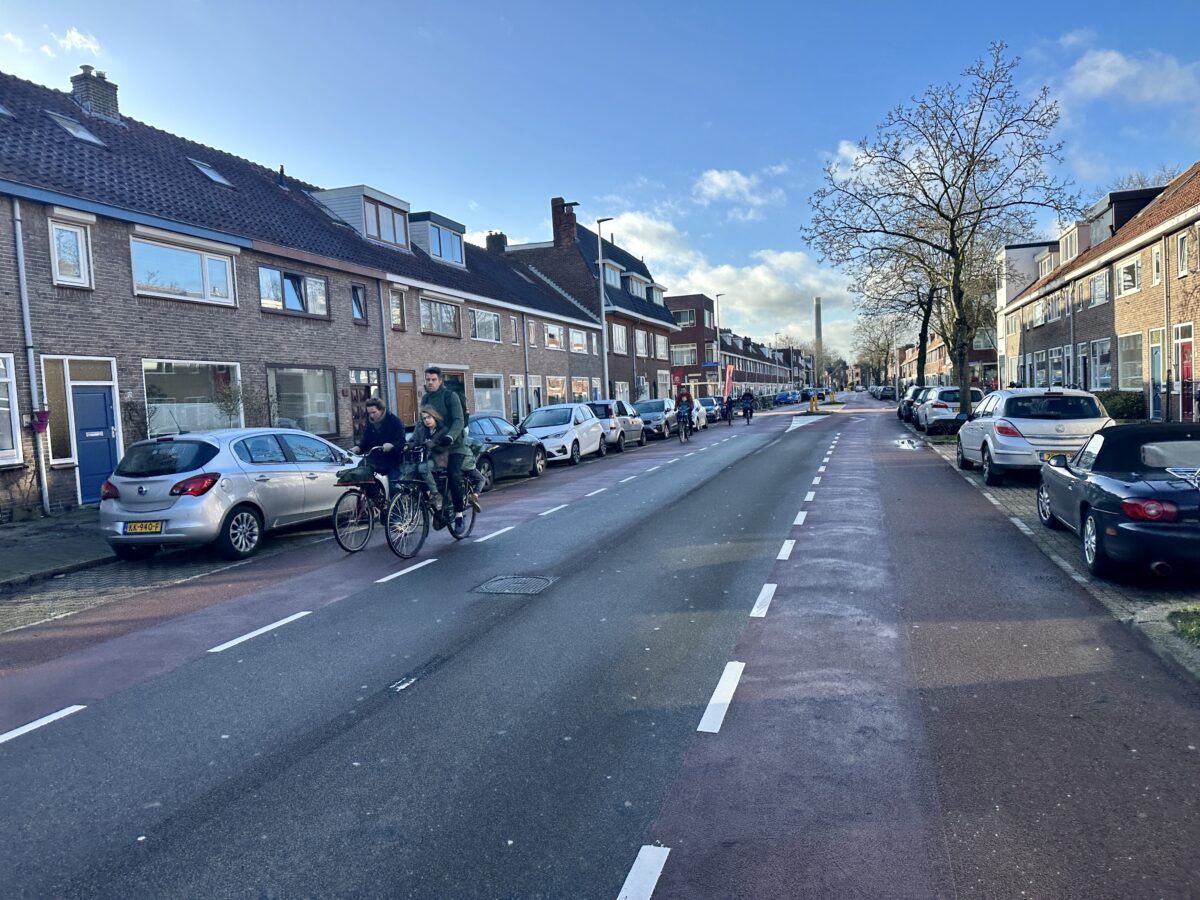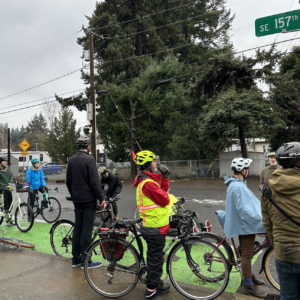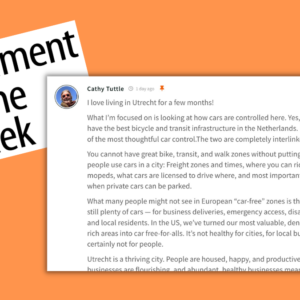

Info Box
- Fact
- Fact 2
- Fact 3
— This post is part of BikePortland Staff Writer Taylor Griggs’ trip through Europe. See previous dispatches here.
In Utrecht, people driving cars are treated like bicyclists are in Portland.
Much has been made about advisory bike lanes in Portland over the last few months; and it just so happens I’m currently in the Dutch city that helped inspired them.
Advisory bike lanes or advisory shoulders (when there’s no sidewalk), also known as “edge lane roads”, create dedicated space for bicycling on either side of a narrow, low-traffic street, leaving the center lane to be shared between car traffic in both directions. But the bike lanes are striped with dashed lines, indicating that drivers can pass into them briefly if they have to pass another car coming toward them (and there isn’t anyone using the adjacent bike lane). You can read our previous coverage for a more detailed look at what this infrastructure entails.
These new installations are exciting to PBOT planners and many bike advocates. To conflict-wary planners, advisory bike lanes are good because they’re fairly uncontroversial and don’t require completely redesigning a street. And advocates are happy the city is exploring new ways to include bike infrastructure on streets that might otherwise be without. Plus, this type of street design is a Dutch import, and anything that makes Portland look a little more like The Netherlands is great, right?
So of course, I was keen to look out for this infrastructure while biking around in The Netherlands, where I am right now. I spent the morning yesterday cycling through Utrecht, a city near Amsterdam that’s known for being even more bike friendly than its more internationally-recognized neighbor (Utrecht was was ranked the best bike city in the world this year). It didn’t take long to find what I was looking for: I just had to veer out of the mostly carfree city center a bit into a more residential area, where some people actually own cars.


Before I continue, I have a few caveats. First of all, this infrastructure is very new to Portland, and I’ve only had the chance to ride on one street with the design, in outer northeast on San Rafael street. And I liked using the San Rafael advisory bike lanes, especially because PBOT bike coordinator Roger Geller was there as a guide to explain the project. I think this design is safer for people biking than the situation on most of Portland’s neighborhood greenway streets. The striping makes it clear to all road users that people biking are prioritized, which is not always the case for people using the greenway system.
As far as the design goes, the streets with advisory bike lanes in Portland and Utrecht look very similar. But the utility of this infrastructure is quite different, and I believe that comes down to the huge cultural differences in each city.
In Utrecht, people driving cars are treated like bicyclists are in Portland. The city makes accommodations for them to get around, but their convenience is clearly not the priority. If you’re going to drive a car in Utrecht, you must navigate around the carfree city center and network of bike paths, and it will probably take you longer to get to your destination.
From my observations, there’s an atmosphere of deference — not agitation — from drivers toward people biking. So on streets with advisory bike lanes where drivers are allowed to share space with people biking, the people on two wheels remain in control.
Like I said, I prefer the advisory bike lanes to greenways or unmarked “shared roadways” in Portland. But after some time observing traffic in Utrecht, it’s all the more clear to me that planners need to realistically consider driver behavior when designing infrastructure. Even if people biking legally have the right-of-way or are supposed to be able to use a street without stress, that’s not always (ahem, pretty much never) how it really plays out. (I get tailed too closely by drivers while biking on Portland’s greenways just about every day.)
This culture of car dominance is all the more prominent in east Portland, where the advisory bike lanes have just been installed on NE San Rafael. It is only very recently that east Portland has seen the development of sufficient bike infrastructure at all, and it’s going to take more than a few lines of paint to make people feel safe biking in the area. In order to turn Portland into a place comparable with Utrecht, we have to take bigger steps to mitigate car use. Only then will things like advisory bike lanes serve their purpose and reach their potential.








Thanks for reading.
BikePortland has served this community with independent community journalism since 2005. We rely on subscriptions from readers like you to survive. Your financial support is vital in keeping this valuable resource alive and well.
Please subscribe today to strengthen and expand our work.
Wow, I love this.
This is the biggest hurdle we have in area that were built to be car-dependent from the get go or have been car dependent for generations – there is a culture that needs to be changed. Infrastructure won’t do anything no matter how good it is until people start to really see a bicycle as a valid transportation option. For many, that first moment of really putting your life into the hands of drivers ruined the experience. This is that hard chicken and egg scenario – how do we build infrastructure that fosters bike culture without the bike culture to support those projects?
I can’t wait to try out the new advisory bike lanes in Portland – I need to plan a ride to check them out. I hope they can deployed in the suburbs due to their low cost and ROW friendliness on very low traffic streets.
Seconding the need for culture shift. Additionally things like infrastructure changes and other tools implemented need to be communicated to the people intended to use them, and we need to be able to validate that those communications are effective. Teaching and testing upon license renewal, in my opinion, seems like a great place to start.
Yeah, it is kind of insane that in order to operate a car legally you need to pass a test once and then never again. It reinforces that feeling that driving is a right, and it can never been taken away once gained. Because, y’know, the laws will never be updated, driving ability is static, and bad habits never form.
Although, taking away people’s licenses would be ruining a person’s life in most places in America. I wonder – it took 50 years for the Netherlands to turn this around, how long will it take us?
Yes. A major cultural shift definitely needs to happen. Even at it’s bike friendliest, I doubt Portland even came close to the bike friendly culture of the Netherlands. Even since I moved to Portland in the late 2000’s, it seems like a lot more people drive.
Sentence of the week: “For many, that first moment of really putting your life into the hands of drivers ruined the experience.” Thank you!
What would it cost to stripe the Greenways as advisory bike lanes?
Why would you want to? On greenways the whole street is an advisory bike lane. Striping would just reduce space and push me over towards the door zone. No thank you!
Compromise: Large painted decals like what we see in soren’s picture, but twice the width, arrows pointing both directions and on every green way.
So … sharrows?
Indicators of who has priority.
Back in the day BL also asked PBOT to install these but they rolled their eyes and lectured us about the existence of other modes (e.g. people driving SUVs):
Sure, if you like, but I personally don’t really care about the markings. They don’t solve any problem that I’ve observed (with a few specific exceptions.)
Most neighborhood streets are pretty good places to ride. I don’t understand the complaints some folks have. PBOT won’t make them much better by adding paint and signs and other clutter, and I wish they’d just fix the pavement and sweep a little more often, then focus on selected intersections and other tricky spots.
Sometimes less is more.
I agree with you here Watts. Good crossing, smooth pavement to ride on, and traffic diverters to keep neighborhood streets low-traffic would go a long way to improving the network.
A lot more for a lot worse result than adding/enforcing “Local Traffic Only”
Excellent piece, Taylor. Concise and accurate. I feel exactly what you’re saying. Looking forward to reading more of your thoughts as you continue your trip.
I remember increasing deference to (and awareness of) people biking in the inner SE in the mid 2010s but it feels like that has been mostly lost.
This conclusion really puts the stresses of riding on PBOT infrastructure experiments in context. PBOT could start educating motorists about who has priority on bike streets (neighborhood greenways) by installing bikes may use full lane signs and supersharrows*. (We, of course, need far more diversion and traffic calming but we also need to indicate who has priority.)
Or paired with “Do not pass” on narrow bike streets.
*anyone remember PBOT’s promise to install these on SE/NE 28th
God these things are awful. You get to share space with an inattentive motorist, who wont understand the infrastructure and sometimes wont be able to see it (like at night). Don’t worry, in exchange for zero protection you get forced to ride in the door zone. Huzzah!
Are there examples of these clusters working in the United States? At the end of the day they rely on drivers being patient and responsible with their vehicles, which is not something I’d bet my life on here. The Netherlands has actual punishments for committing crimes in your vehicle. I’m guessing that plays a part in how useful they are.
PBOT loves these things because they don’t work. Its the same with the beg barrels. Projects like these are “uncontroversial” because they don’t do anything, and therefore don’t anger motorists.
San Rafael was already a shared space before. It didn’t have bike lanes, and it still doesn’t have the width for bike lanes. Same thing at NE 53rd. Sharrows or advisory lanes. Pick your poison.
Sharrows. No question. I’d rather be in the middle of the lane than at its edge.
Sharrows so I only have to worry about being run down by someone playing on their phone rather than having to worry about that AND getting doored by someone not paying attention.
Well said, Taylor.
Advisory lanes, as implemented in Portland, are merely another form of 4ft bike lane with magical paint protection. They will do nothing to increase bike usage because they aren’t safe.
The person in the giant truck or SUV will continue to dominate the street, staring at their phone all the while.
If only. They’re another form of 4ft bike lane that cars can drive on.
I agree with you. As long as cars keep increasing in sizes and concentration reduces and disregard for cyclists still exists, safety is still a big issue.
Side point–I like the one photo’s trees planted in the parking. The trees and their planters can be much wider than if they were squeezed onto the sidewalk they way they are here, plus the sidewalk remains clear.
Assuming you’re taking lots of photos, I bet you’ll be seeing all kinds of good examples in them after you get back–even more than you’re noticing while you’re there.
I’ve always liked Utrecht – I’ve been there 4 times since I was a teenager in the mid 80s – and it has changed a lot. It’s a nice small city, an outer suburb of Amsterdam in the same way as Salem is to Portland, lots of history, a gentle Catholic enclave surrounded by rabid Protestant Dutch provinces. But it isn’t really comparable to Portland in the same way as say Rotterdam or Antwerp, IMO. Far smaller and far less dense. And comparing a residential street in the suburban Russell neighborhood of East Portland to an inner neighborhood urban street of Utrecht is a bit like comparing Pioneer Square to a Walmart parking lot – both have traffic calming, but what’s the point?
Ah yes, Utrecht is less dense than Portland so this comparison is useless.
*Looks at pictures*
Wait, how is that less dense than Portland? Why does it matter the population of the metro area is when talking about bicycle infrastructure at this scale? Bicycle infrastructure doesn’t involve insane investment like a subway line, and it scales pretty well. A bicycle route shouldn’t look different in design if it is in Salem or in Portland.
Actually, I was comparing Utrecht to Rotterdam or Antwerp on density, but I can see how I did a bad job in saying that.
Wait, what? Utrecht is twice as dense as Portland, and about 60% the population. They are really fairly comparable. There are big differences, though: the Portland metro region is much bigger than Utrecht metro. Portland had big freeways within the city, and stroads, where Utrecht does not. Portland has very low density areas in the southwest, northwest, and outter east, while Utrecht is generally fairly uniform density outside the central city. There are parts of Portland that are high density, but there are also parts of Utrecht central city that are high density. The cities are not so different as to not be comparable, and there’s no reason to think that anything other than culture and attitudes is preventing Portland from successfully implementing transportation systems that work in Utrecht.
The A2 goes through Utrecht and the A12 and A27 go through the periphery of the city. There are also many LA-Style cloverleafs where these freeways meet…in Utrecht.
There is also a heck of a lot of parking on the periphery of the city. For example, the IKEA has a massive two story parking lot that is covered by two football pitches.
Looking at a map, I see that you are correct. There is a freeway cutting through the middle of Utrecht. But I think that further illustrates the point that Utrecht and Portland are not so dissimilar as to not be comparable, and that bike infrastructure that works in Utrecht can work in Portland.
I personally prefer Amsterdam style, fully separated facilities wherever possible, as well as more aggressive application of car diverters in residential neighborhoods. But there are a lot of good things happening in Utrecht from a transportation perspective.
I agree. I think the biggest barrier is political, not structural/geographical (and this is why I am so critical of milquetoast reformism).
Well, and money, but with the right culture and attitudes, the money would be available. But culture and attitudes (and money) are basically everything in this arena, not some small obstacle that can be swept aside by a well meaning bureaucracy.
Almost any societal problem can be solved, any transformation can occur, with the right culture and attitudes (and money).
I was born and raised in Utrecht; if you have questions comparing Utrecht with Portland, Amsterdam, Rotterdam, please let me know. Happy to clarify. But you are hurting my feelings stating Utrecht is an outer suburb of Amsterdam. That’s calling Portland an outer suburb of Seattle ;).
I’m sorry if I’ve offended you, but when I was last there 10 years ago, there were far more train users heading from Utrecht to Amsterdam in the morning than the reverse, which to me would indicate that Utrecht is a bedroom suburb of Amsterdam – many folks live in Utrecht because it is quieter, cheaper, easier to bike in, etc, but Amsterdam pays better and has more opportunities. Has this changed over the past decade? Is the flow now more balanced?
As for Portland being a suburb of Seattle, yeah, I’ve heard a lot of people say it is. Without fear of contradiction I can say that the Oregon state legislature in Salem is a suburb of Seattle – note how much they are willing to rebuild any perceived bottlenecks going up to Seattle (CRC2, Rose Quarter) at the neglect of badly needed infrastructure in the rest of the state. There are more trains between Portland and Seattle than between Portland and Eugene; Oregon’s density increases the closer you get to Washington state rather than to California. And so on.
A suburb that’s 4 hours away?
By that logic, Portland is a suburb of Tokyo (Oregon population is skewed to the west of the state) and Seattle is a suburb of Vancouver, BC (Washington’s population is skewed northward). More trains from Portland to Seattle than Eugene is also irrelevant, and few people would say Eugene is a suburb of Portland anyway.
I’ve lived decades in Seattle and Portland, and never knew a single person who lived in one and worked in the other. I can’t think of any category that indicates that one place is a suburb of another being true in any meaningful way in regard to Portland and Seattle.
Door zone bike lanes that encourage drivers to play chicken with oncoming cars and then swerve into the bike lane at the last minute to avoid a head on collision. Beautiful. What could got wrong?
Except people aren’t getting doored left and right in Utrecht. Nor are they getting clobbered by cars on a regular basis. ABLs work.
When I was in Utrecht, I never once saw a car without a license plate either, driving seemed very orderly, and the traffic police were visible, so we could learn a lesson from them on that front as well.
Though, I should add, one of the most aggressive drivers I’ve driven with in Europe (or America) was Dutch.
Again, different culture. Lots of things are possible when drivers are more aware of bikes.
I live just off 53rd by the new advisory lanes, and I ride San Rafael regularly. Neither of these have door zones. As you can see in the picture, there is a buffer to the right of the stripes zone on San Rafael, and parked vehicles are generally off to the side. I haven’t encountered any issues with either installation, as a rider and driver.
Have you encountered any benefits of the installation?
I have seen some confusion on 53rd, but drivers seem to be figuring out how they can get around slow cyclists on the bridge. I would see a lot of close passes before. As a driver, I haven’t had anyone try to crash into me head-on on 53rd.
I only bike on San Rafael, and it has been an improvement, at least for me as a relatively fast rider. I do about 20mph, and I had issues with people riding my ass from behind, afraid to commit to a full pass with intermittent speed bumps slowing them down. If they did pass, they usually cut it pretty close. With the advisory lanes, it’s obvious where I should be riding, and where they should be driving when passing. I haven’t had any head-on experiences yet.
I just spent a month in Eindhoven. About half of the streets are like this. I found it to be an amazing way to “govern” car speeds. Never had trouble with conflict because everyone is moving slowly. If you give a car a full lane they will always go too fast to be in interactions with bikes.
Thanks, Taylor, for this interesting article. The thing missing for me was a description of what it’s actually like to ride in an “advisory” bike lane. What do you do when you meet a car blocking your lane? Or does that never happen in Utrecht? And how do drivers behave when their cars meet in the center lane? I’ve never ridden in an ABL so I’d like to know what behaviors you experienced.
A crucial distinction from the side-by-side photos is the different colored pavement for the Utrecht advisory bike lane. It clearly distinguishes the spaces and the auto driver in Utrecht would have a solid idea that the red-tinted brick was for bikes. In comparison, the NE San Rafael photo shows a configuration that is less distinct, and, like too much Portland bike infrastructure, such as sharrows, lacks a clear cultural understanding and leaves too much guesswork for drivers.
When I look at NE San Rafael compared to most of the greenways, I’d much rather bike on a greenway. As others have noted, the whole street on a greenway is essentially an advisory bike lane. While there are at times conflicts on the greenways between bike riders and auto drivers, for the most part, I’d much rather take the lane on a street like Ankeny than cross my fingers that drivers would do the right thing on advisory bike lanes.
We simply don’t have the car culture necessary to make advisory bike lanes a safe enough option for widespread use. Besides, like many have said, PBOT should do a more thorough job of implementing diversion and traffic calming infrastructure. The “May Use Full Lane” on all greenways would be nice as well.
Ultimately, it feels like advisory bikes lanes in Portland just allow PBOT to once again skirt on real, comprehensive protected bike lane infrastructure.
I agree about the pavement color being an essential element of the advisory bike lane concept. In my opinion, skip striping alone doesn’t convey a clear sense of distinct zones for road users. The San Rafael rendition is not very understandable, as the photo showing the oncoming white car demonstrates. I’d suggest PBOT try a segment on the same street using colored pavement outboard of the striping and document how, or if, that influences driver behavior.
Drivers in most of Europe have to experience actual driver training; there is actually enforcement of traffic laws; there are actual consequences. Besides, there seems to be a higher degree of respect for bicyclists and people in general.
In a month of riding across France many years ago, we were never, even once, cut off, intentionally intimidated or honked at in anger.
I don’t think we can import good ideas from Europe and expect them to work as they do there.
As much as anything, I’m looking beyond the “mostly carfree city center” of Utrecht that I’m familiar with, and seeing the kind people-friendly housing (never mind taxes, etc.) that make alternatives to driving more practical.
It’s not too different from where I lived during my earliest memories, except that being American, it has to be ironic. The nearest supermarket was over two miles down the highway, with a velodrome on the other side of the road. It appears that they have a big box power center nearby, putting Costco and Whole Foods within a mile. Considering how many cars in those parking lots are worth more than a house down the street from mine in foreclosure…